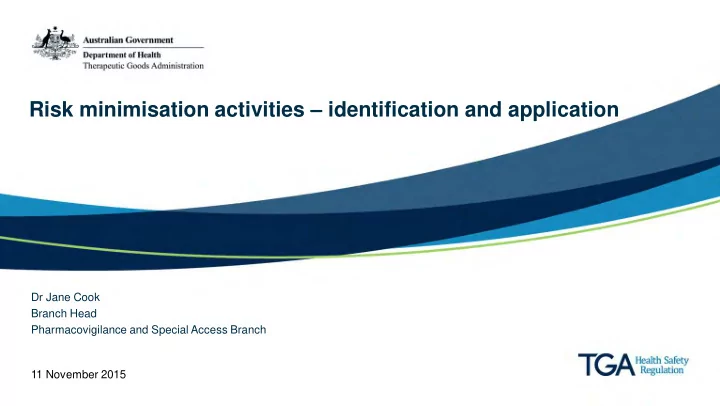

Risk minimisation activities – identification and application Dr Jane Cook Branch Head Pharmacovigilance and Special Access Branch 11 November 2015
What are risk minimisation activities? • Initiatives that attempt to positively influence patients or health care professional behaviours, and through these changes lead to an improved patient outcomes • Focus on minimising harms • Need to plan the level of change or achievement of outcome indicators that the intervention was successful • A protocol for how the evaluation will occur needs to be developed and this should specify the metrics and thresholds by which the programme success will be measured and audited • Should be supplied with the Risk Management Plan (RMP) 1
Risk minimisation activities Focus on: • Risk prevention – identifying those at particular risk through testing and not prescribing, adjusting dose, etc. • Risk mitigation – usually relies on monitoring during therapy to identify increases in risk and allow for intervention • Neither preventable or able to be mitigated – may be acceptable depending on the risk-benefit profile 2
Types of risk minimisation activities • Communication – DHCP letters/information – Prescribing dispensing guidelines – Patient brochures, alert cards – Education • Restricted access – Registration programmes for patients – Certification programmes for prescribers/dispensers – Limited pack size, repeats, dosage forms – Dispensing linked to test confirmation – Certain types of prescribers – Limited to patient specific group – limited pharmacogenomic profile • Controlled regulatory framework - scheduling 3
Tool selection factors • Will depend on the following factors: – Risk identification : recognition (existence of a risk) and characterisation (level of risk) – Goal setting : goals, objectives and targets – Health care system integration : adaptation to local requirements – Evidence-based activities : based on scientific literature or other evidence – Proportionality/Burden considerations : reasonable minimisation-burden balance • A comprehensive strategy may require a range of interventions 4
Tool selection Risk identification • Patient journey mapping (from point of diagnosis until drug cessation, incl. risk) • For any part of the patient journey: – Identification and characterisation of points where additional risk minimisation may be needed – Identification of stakeholders (i.e. the target of the intervention) 5
Tool selection Risk identification • For each potential issue: – Risk recognition (triage/signal detection) – Risk characterisation and categorisation: § Consider severity/likelihood (for risk-benefit balance and public health impact) – Risk categorisation: § By level of evidence (important identified risk, important potential risk, missing information) § By level of risk 6
Tool selection Goal setting • Identification of: – Goals (global strategy for risk minimisation) – Objectives (how the goal is achieved) – Targets (stakeholders or sites of risk minimisation intervention) • Consider SMART criteria for goals and objectives – specific, measurable, achievable, relevant, time-bound. 7
Tool selection Health care system integration and burden considerations • Analysis of health care system: – Considers existing health care system (incl. health care infrastructure; prescriber characteristics; potential variability in standards of care across regions) – Considers patient requirements (incl. access for vulnerable populations) – Considers proportionality and potential burden: § Individual vs. population burden § Burden tolerance (potentially higher for more favourable risk-benefit balance) § Prior stakeholder experience 8
Tool selection Evidence-based activities • Additional risk minimisation activities should be evidence based • Potential considerations include: – Comprehensive literature review (including competent authority websites and grey literature) – Experience with similar products 9
Tool selection Tool matching • One tool can address more than one objective and an objective could be addressed by more than one tool. • Consider choosing the most effective tool to achieve an objective. • Tools need to achieve an acceptable risk-benefit balance for a product. 10
Governance • The governance structure should provide: – Approval, advice and oversight of the process and plan; – Consistency of local programmes with the strategy, risk minimisation plan and regulatory requirements; – A robust tracking system for local implementation; – Appropriate metrics and corrective and preventive actions (CAPA) and their regular review; – Adequate resources for implementation and evaluation. 11
Implementation • In implementing its risk minimisation strategies, MAHs should ensure: – Adequate internal communication and infrastructure, including the education of key internal stakeholders; – Support of local implementation efforts including development of a core risk minimisation plan and tools, provision of educational materials for affiliates on their use, and institution of tracking procedures that provide a way to measure implementation of risk minimisation activities at the local level. 12
Risk Minimisation Programme • You have identified the risks to be mitigated. • You have selected the tools (activities) to be used in the programme. • You need to ensure appropriate governance and implementation. • You now need to ensure the activities will meet their objectives and be successful in mitigating the identified risks (separate presentation). • You now need to develop an evaluation framework (separate presentation). 13
Summary • Life-cycle approach • Should be simple, pragmatic and user friendly to prevent undue clinician and patient workload • Risk management programme should aim to in the real world ensure that “the right prescriber provides the right medicine to the right patient at the right dose and right time”. • Appropriate implementation and governance measures need to be in place. 14
Recommend
More recommend